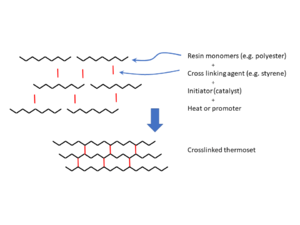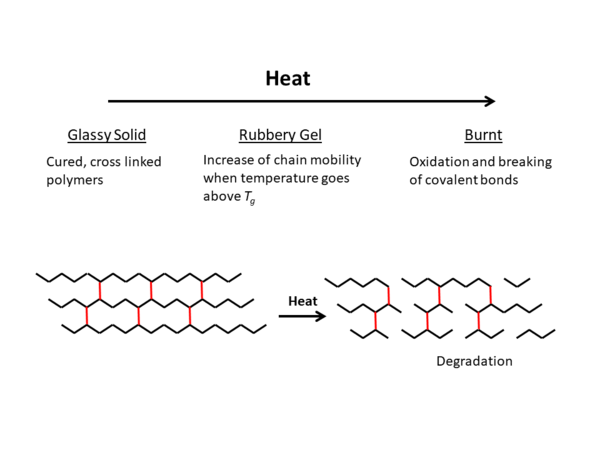Thermoset polymers - A105
| Thermoset polymers | |
|---|---|
| Foundational knowledge article | |

| |
| Document Type | Article |
| Document Identifier | 105 |
| Themes | |
| Relevant Class |
Material |
| Tags | |
| Prerequisites | |
Introduction[edit | edit source]
Thermoset or thermosetting polymers are one of the two groups of polymers (the other being thermoplastics). They are characterized by the molecular crosslink covalent bonds that are formed between adjacent primary polymer chains. Thermosets undergo polymerization and crosslinking during a curing stage, which in many cases occurs with the aid of a hardening agent and heating or promoter.
Thermoset precursor materials may be of low molecular weight, and some after mixing will flow and crosslink at room temperature [1] – allowing for relative ease to process. However, many thermosets require the input of heat to complete the curing (crosslinking) process.
Scope[edit | edit source]
This page provides a brief overview to the family of polymers classified as thermoset or thermosetting polymers. It briefly covers their molecular structure, their material forms, and an introduction to the thermoset curing process and their post-cured properties.
Significance[edit | edit source]
Thermosets are a popular polymer matrix material for fibre reinforced composites. Common examples include polyesters and epoxies. They are the most predominant type of matrix system, particularly in the aerospace market segment. Thermoset matrix composites are more widely used than thermoplastic matrix composites due to their lower viscosity at relatively low temperatures (less than 100°C), which better facilitates the resin/fibre wetting process [2].
Prerequisites[edit | edit source]
Recommended documents to review before, or in parallel with this document:
Overview[edit | edit source]
Thermoset or thermosetting polymers are one of the two groups of polymers (the other being thermoplastics). Thermosets undergo polymerization and crosslinking during a curing stage, which in many cases occurs with the aid of a hardening agent and heating or promoter. Initially, they behave like a viscous fluid. During curing, they change from viscous fluid to rubbery gel (viscoelastic material) and finally glassy solid. If heated after curing, initially they become soft and rubbery at high temperatures. If further heated, they do not melt but decompose (burn). As a result, thermoset polymers are considered single use materials as they cannot be reprocessed.
Crosslink Structure[edit | edit source]
Thermosets are characterized by their molecular crosslink structure, where adjacent linear polymer chains are joined together by covalent bonds. Often, the crosslink structure is accomplished by additive atoms and molecules that are covalently bonded to the chains [3]. It is these bonds that form between the chains that give the crosslink structure its name.
Thermoset resins often come in two parts: part A (resin) and B (crosslinking curing agent, or sometimes referred to as hardener). The ‘curing reaction’ (curing process) is the physical synthesis between these two substances by a chemical reaction.
Material Forms[edit | edit source]
Uncured thermoset polymers often come in the form of a liquid resin that is to be combined with reinforcement fibres in either a hand lay-up or liquid composite moulding composite manufacturing process. They can also be provided in a partially-cured and tacky almost solid-like state in the form of a resin film that is to be used in resin film infusion processes. Extending the latter form, another popular handling form for thermosets is to be pre-combined with reinforcement fibres as a B-stage prepreg material.
Please see the systems catalogue for more information regarding thermoset resin material forms (Thermoset Polymers - Systems Catalogue page).
Curing and Final Properties[edit | edit source]
Link to main Curing of Thermosetting Polymers page
A curing process is necessary to polymerize the thermoset polymer and form the molecular crosslink structure responsible for their desired properties. During this process, the thermoset polymer transforms from a flowing liquid resin into a rigid polymer. Curing can be initiated by various means depending on the particular polymer system; heat, radiation, chemical additives, etc., or a combination of these.
Heat is often employed as part of this process to fully cure the polymer. An example of a cure process temperature profile and the evolution of the crosslinking process (represented as degree of cure) is shown below.
Once curing is complete, fully cured thermosets exhibit the following [4]:
- Excellent environmental resistance
- Excellent solvent resistance
- High mechanical strength and stiffness
- Low toughness (downside)
After curing, if heated to very high temperatures, thermosets chemically breakdown.
- Initially softening
- After time, transforming into char
Example Thermoset Materials[edit | edit source]
Examples of popular thermosets used as polymers matrices include:
- Polyesters
- Vinyl esters
- Epoxies
- Phenolics
- Bismaleimides
For more information on popular thermoset matrix materials, see the catalogue volume thermoset matrix page.
Related pages
References
- ↑ [Ref] McCrum, N. G. et al. (1997). Principles of Polymer Engineering. Oxford University Press. ISBN 978-0-198565-26-0.CS1 maint: extra punctuation (link) CS1 maint: uses authors parameter (link) CS1 maint: date and year (link)
- ↑ [Ref] Hoa, S V (2018). Principles of the Manufacturing of Composite Materials. DEStech Publications, Incorporated. ISBN 9781605954219.CS1 maint: uses authors parameter (link) CS1 maint: date and year (link)
- ↑ [Ref] Callister, William D. (2003). Materials Science and Engineering: An Introduction. John Wiley & Sons, Inc. ISBN 0-471-13576-3.CS1 maint: uses authors parameter (link) CS1 maint: date and year (link)
- ↑ [Ref] Pilato, Louis A.; Michno, Michael J. (1994). Advanced Composite Materials. Springer-Verlag Berlin Heidelberg. doi:10.1007/978-3-662-35356-1. ISBN 978-3-540-57563-4.CS1 maint: uses authors parameter (link) CS1 maint: date and year (link)
| About | Help |
Welcome
Welcome to the CKN Knowledge in Practice Centre (KPC). The KPC is a resource for learning and applying scientific knowledge to the practice of composites manufacturing. As you navigate around the KPC, refer back to the information on this right-hand pane as a resource for understanding the intricacies of composites processing and why the KPC is laid out in the way that it is. The following video explains the KPC approach:
Understanding Composites Processing
The Knowledge in Practice Centre (KPC) is centered around a structured method of thinking about composite material manufacturing. From the top down, the heirarchy consists of:
- The factory
- Factory cells and/or the factory layout
- Process steps (embodied in the factory process flow) consisting of:
The way that the material, shape, tooling & consumables and equipment (abbreviated as MSTE) interact with each other during a process step is critical to the outcome of the manufacturing step, and ultimately critical to the quality of the finished part. The interactions between MSTE during a process step can be numerous and complex, but the Knowledge in Practice Centre aims to make you aware of these interactions, understand how one parameter affects another, and understand how to analyze the problem using a systems based approach. Using this approach, the factory can then be developed with a complete understanding and control of all interactions.
Interrelationship of Function, Shape, Material & Process
Design for manufacturing is critical to ensuring the producibility of a part. Trouble arises when it is considered too late or not at all in the design process. Conversely, process design (controlling the interactions between shape, material, tooling & consumables and equipment to achieve a desired outcome) must always consider the shape and material of the part. Ashby has developed and popularized the approach linking design (function) to the choice of material and shape, which influence the process selected and vice versa, as shown below:
Within the Knowledge in Practice Centre the same methodology is applied but the process is more fully defined by also explicitly calling out the equipment and tooling & consumables. Note that in common usage, a process which consists of many steps can be arbitrarily defined by just one step, e.g. "spray-up". Though convenient, this can be misleading.
Workflows
The KPC's Practice and Case Study volumes consist of three types of workflows:
- Development - Analyzing the interactions between MSTE in the process steps to make decisions on processing parameters and understanding how the process steps and factory cells fit within the factory.
- Troubleshooting - Guiding you to possible causes of processing issues affecting either cost, rate or quality and directing you to the most appropriate development workflow to improve the process
- Optimization - An expansion on the development workflows where a larger number of options are considered to achieve the best mixture of cost, rate & quality for your application.
To use this website, you must agree to our Terms and Conditions and Privacy Policy.
By clicking "I Accept" below, you confirm that you have read, understood, and accepted our Terms and Conditions and Privacy Policy.







